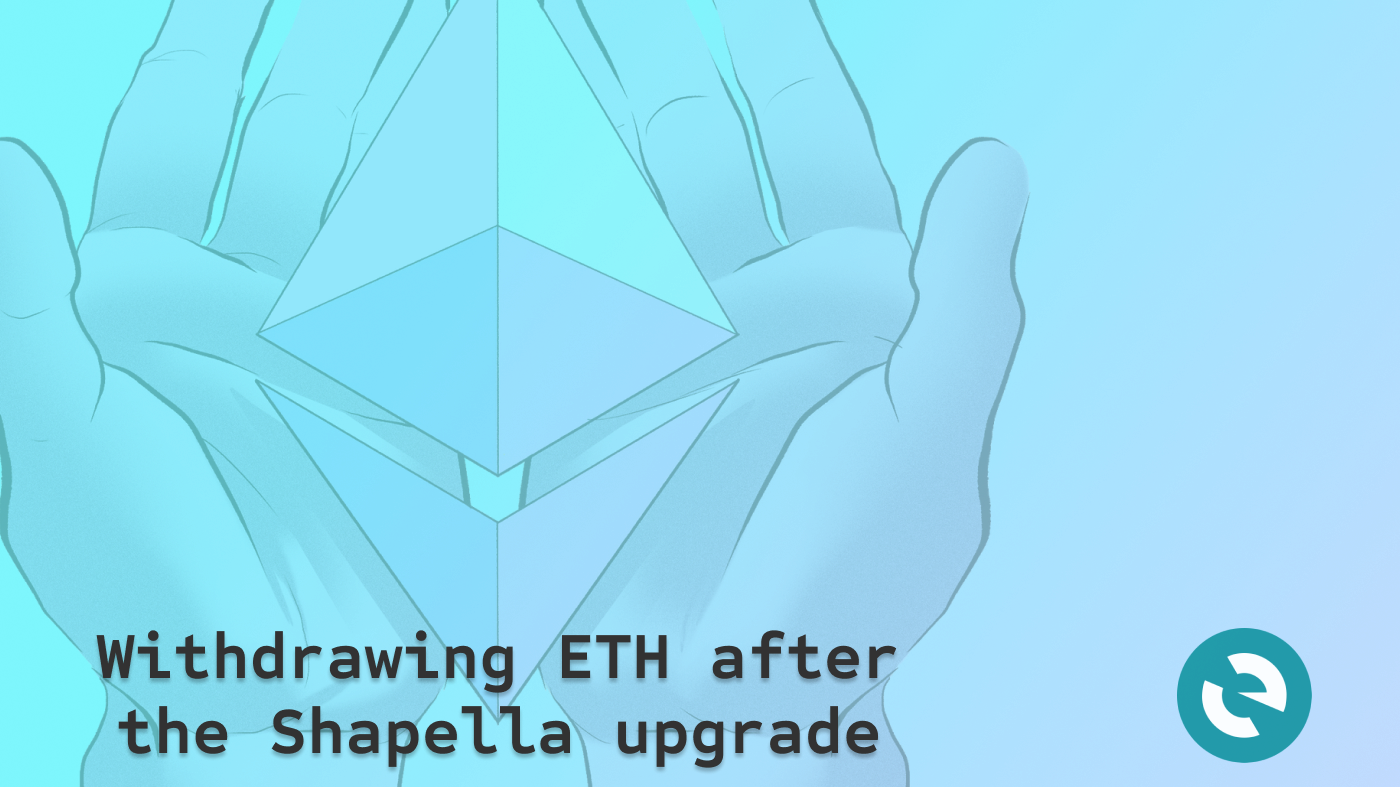Update: Since the publication of this article, the Shapella upgrade has taken place and the withdrawals of staking rewards and staked ETH are now enabled on Ethereum. If you staked on Ethereum via MEW web or MEW wallet, you can now set your withdrawal address, withdraw rewards, exit the validator, if desired, and re-stake at any time. Write to support@myetherwallet.com for assistance.
Although Ethereum started as a Proof-of-Work chain in 2015, the transition to Proof-of-Stake (PoS) was always part of Ethereum’s roadmap. When Ethereum launched, PoW was a tried and tested consensus algorithm that had kept Bitcoin secure for many years, but it was very energy-intensive and offered limited scaling possibilities.
Transitioning to PoS would dramatically reduce Ethereum’s energy expenditure, lower barriers to entry for validators, and allow the Ethereum ecosystem to expand at an accelerated rate. Staking on the PoS Beacon Chain (also known as Ethereum 2.0) was first launched in December of 2020.
At this early point, staking on Eth2 was an expression of strong faith in Ethereum’s development, since stakers knew that their ETH would be locked until an unknown time in the future when the existing PoW Ethereum chain would be merged with the PoS Beacon Chain.
The Merge happened in September 2022. It was recognized as one of the most significant achievements in the history of blockchain technology, but did not enable withdrawals of staked ETH and rewards as many users expected. That would require an additional upgrade – again, at an unknown time in the future.
Now, finally, this highly anticipated upgrade is just a week away, scheduled to take place on April 12th! The upgrade is called Shapella – the combination of ‘Shanghai’, the upgrade on the Ethereum execution layer, and ‘Capella’, the upgrade on the consensus layer, which will happen simultaneously.
It’s important to keep in mind that after the upgrade all withdrawals will be subject to a withdrawal queue. While the withdrawals of the accumulated staking rewards (called ‘partial withdrawals’) will be automatic and relatively quick, the withdrawals of the entire 32 ETH validators (called ‘full withdrawals’) will need to be initiated manually and will be done at a slower pace to preserve the stability of the network. To learn more about the way withdrawals work, see the Ethereum.org help page.
According to current calculations, it should take no more than 5 days for a withdrawal to be processed, whether it’s a withdrawal of rewards or withdrawal of a full validator. However, that doesn’t necessarily mean the ETH will appear on the withdrawal address within that time. Withdrawals of rewards could take anywhere from a few hours to a few days, but getting the full 32 ETH with a validator exit could take weeks or even months, depending on how many validators are in queue. For details on these calculations and other withdrawal information, see the Ethereum.org Withdrawals FAQ.
What does this mean for MEW users who staked ETH through MEW wallet or MEW web?
After the Shapella upgrade, those users who staked full 32 ETH validators via Staked.us (in MEW wallet or on MEW web) will be able to receive their accumulated rewards and also exit the validator by withdrawing the 32 ETH principal, subject to the Ethereum withdrawal limits and queue.
MEW users who staked via liquid staking providers Lido (in MEW wallet) and StakeWise (in MEW web) did not have their ETH ‘locked’ in the same sense as the full validators, because they could use the liquid derivative tokens in other DeFi protocols across the ecosystem. Still, with the Shapella upgrade, both Lido and StakeWise are making some protocol updates of their own, and users may want to take advantage of these new opportunities.
Read on to see specific unstaking information depending on which provider and platform you used.
Staked.us: full validator staking on MEW wallet and MEW web
If you staked 32 ETH for a full validator through Staked.us on MEW web or MEW wallet app, you will need to update the withdrawal address credentials before you can withdraw staking rewards and/or exit the validator. We are working with Staked.us to update our interfaces so that you can update the withdrawal address and take all necessary actions from the MEW wallet where you staked (web or mobile app). This interface update will be released soon after the Shapella upgrade.
In the meantime, your staked assets are safe and continue earning rewards during and after the Shanghai (aka Shapella) upgrade. If you are not interested in withdrawing your rewards and staked ETH as soon as possible, there is no urgency to updating your withdrawal credentials. Validators that don’t have an updated withdrawal address continue to accumulate rewards. The automatic withdrawal of rewards will only happen if and when the withdrawal address credentials are updated.
How Staked.us withdrawals will work in MEW:
Once you update the withdrawal address credentials, the accumulated staking rewards will be transferred to your withdrawal address automatically. You may note that your staking rewards now include not just the validator rewards that are earned for block confirmation, but also MEV (Maximum Extractable Value) and transaction fees that were earned by miners before the transition to Proof-of-Stake.
After the first withdrawal, rewards will continue to be deposited to the designated withdrawal address regularly through a ’sweeping process’. How often the rewards will be deposited depends on the Ethereum withdrawal protocol and the number of validators. The rewards deposits are not controlled by MEW or Staked.us, but are an automatic function of an Ethereum smart contract. Find more information about how withdrawal payments work on the Ethereum.org blog.
For a full withdrawal of 32 ETH, the validator exit would need to be initiated by users manually through the Staked DApp in MEW wallet or MEW web. After this is done, it may take weeks to months to receive the full 32 ETH to the withdrawal address, depending on the number of validators requesting to exit. To learn more about the withdrawal process and queue, see this Ethereum.org FAQ.
Our goal is to make these interface updates available shortly after the Shapella upgrade, which is scheduled to take place on April 12. Keep in mind that the timeline for when users will actually receive their staking rewards (or all of their staked ETH, if exiting the validator) also depends on our partner Staked.us and on Ethereum’s withdrawal queue. Please stay tuned to our official social channels for the most up-to-date unstaking information.
Lido: liquid staking on MEW wallet
With the Shanghai (aka Shapella) Ethereum upgrade, Lido is transitioning to V2 to make the protocol more secure, stable, and decentralized. Users who staked with Lido in MEW wallet app do not need to take any immediate action. Your staked assets are safe and continue to earn staking rewards. You can still swap your stETH to ETH at market rates at any time, or continue using your stETH in other DeFi protocols.
With Lido V2, once withdrawals are enabled on Ethereum by the Shanghai upgrade on April 12th, stETH holders will be able to withdraw ETH from Lido at a 1:1 ratio. According to Lido, mainnet withdrawals should become active on the protocol around mid-May, to allow for sufficient auditing and security testing of V2. To learn more about Lido V2, see the Lido blog.
MEW is working with Lido to make relevant updates to our interface, allowing users to withdraw ETH directly in MEW wallet. In accordance with Lido’s timeline, this should become available mid-May, but please stay tuned to Lido’s and MEW’s official social channels for the most up-to-date unstaking information.
StakeWise: liquid staking on MEW web
With the Shanghai (aka Shapella) upgrade, the StakeWise protocol will be transitioning to StakeWise V3, which features a new liquid derivative token model. Users who staked with StakeWise via MEW web do not need to take any immediate action. Your staked assets are safe and continue earning rewards in the form of rETH2. You are still able to redeem your sETH2 or rETH2 back to ETH through the StakeWise DApp interface in MEW web until V3 released, at which point liquidity for sETH2 and rETH2 tokens on secondary markets is not guaranteed.
StakeWise V3 will introduce a single token model with osETH. Previously, stakers received sETH2 tokens for their staked ETH and rETH2 tokens for the accumulated rewards. Now, osETH will represent all ETH staked in StakeWise V3 validators and will grow in value as rewards accumulate. That means that liquid staking will become even easier - just hold osETH in the wallet to earn ETH rewards, and convert back to ETH whenever you are ready to cash out. Find out more about the osETH token on the StakeWise blog. For more technical detail about the transition to V3, see this article.
MEW is working with StakeWise to update the StakeWise DApp in MEW web to reflect the changes introduced by V3. Users will be able to view and monitor the stake that was made on StakeWise V2 and/or transition to StakeWise V3 directly in the MEW web interface.
StakeWise recommends that users staking less than 0.5 ETH either sell (redeem) their sETH2 and rETH2 for ETH before the transition to V3, effectively exiting their staking position, or continue holding sETH2 and accumulating rETH2 until they are ready to unstake in the future. This is because at staked amounts under 0.5 ETH, the gas costs of transitioning from V2 to V3 may be prohibitive.
Users staking more than 0.5 ETH may want to transition to V3 as soon as this option is available in MEW web to take advantage of the new opportunities offered by osETH. Alternatively, they can also continue to hold sETH2 and earning rewards as rETH2 until they are ready to unstake at some later time.
The timeline of the StakeWise DApp update in MEW web depends on the successful completion of the Shanghai upgrade and the mainnet release of StakeWise V3. Users may need to wait several days for the deposit of unstaked ETH, in accordance with the requirements of the StakeWise protocol and the Ethereum withdrawal queue. Please stay tuned to StakeWise’s and MEW’s official social channels for the most up-to-date unstaking information.

